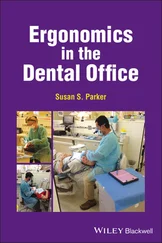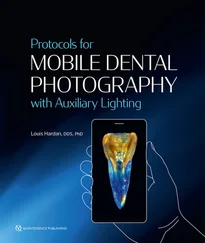Susan S. Wingrove - Peri-Implant Therapy for the Dental Hygienist
Здесь есть возможность читать онлайн «Susan S. Wingrove - Peri-Implant Therapy for the Dental Hygienist» — ознакомительный отрывок электронной книги совершенно бесплатно, а после прочтения отрывка купить полную версию. В некоторых случаях можно слушать аудио, скачать через торрент в формате fb2 и присутствует краткое содержание. Жанр: unrecognised, на английском языке. Описание произведения, (предисловие) а так же отзывы посетителей доступны на портале библиотеки ЛибКат.
- Название:Peri-Implant Therapy for the Dental Hygienist
- Автор:
- Жанр:
- Год:неизвестен
- ISBN:нет данных
- Рейтинг книги:3 / 5. Голосов: 1
-
Избранное:Добавить в избранное
- Отзывы:
-
Ваша оценка:
- 60
- 1
- 2
- 3
- 4
- 5
Peri-Implant Therapy for the Dental Hygienist: краткое содержание, описание и аннотация
Предлагаем к чтению аннотацию, описание, краткое содержание или предисловие (зависит от того, что написал сам автор книги «Peri-Implant Therapy for the Dental Hygienist»). Если вы не нашли необходимую информацию о книге — напишите в комментариях, мы постараемся отыскать её.
Peri-Implant Therapy for the Dental Hygienist
Peri-Implant Therapy for the Dental Hygienist
Peri-Implant Therapy for the Dental Hygienist — читать онлайн ознакомительный отрывок
Ниже представлен текст книги, разбитый по страницам. Система сохранения места последней прочитанной страницы, позволяет с удобством читать онлайн бесплатно книгу «Peri-Implant Therapy for the Dental Hygienist», без необходимости каждый раз заново искать на чём Вы остановились. Поставьте закладку, и сможете в любой момент перейти на страницу, на которой закончили чтение.
Интервал:
Закладка:
Courtesy of Nobel Biocare.
In 1964, commercial‐grade pure titanium was accepted as the material of choice for dental implants. Other bodies of medicine (i.e., joint replacements) had recognized the fact that the body does not recognize titanium as a foreign material, which results in higher success rate and fewer rejections. Eventually, the use of commercial pure titanium evolved into the use of titanium alloys (TiAl 6V 4being the most commonly used) due to experimentation and improved durability.
In 1981, Dr. Per‐Ingvar Brånemark published his findings covering all the data on the animal and human clinical trials: success rate, concept, and the design of endosteal root‐form titanium implants most commonly placed today. In an effort to gain international support and collaboration, based on patient care with sound biological and clinical principles Brånemark founded the Association of Brånemark Osseointegration Centers (ABOC).
Brånemark identified the edentulous patient as an amputee, an oral invalid, to whom we should pay total respect and rehabilitation ambitions. He was also instrumental in identifying the mouth as a much more important part of the human body than medicine and controlling agencies had previously recognized. He coined the term osseoperception , “the dentate mouth communicates with the brain, possibly improving not only daily function but also being an important factor in restitution after intra‐cranial vascular events” (P‐I Brånemark, September 2005).
In the 21st century, technology and clinical awareness will take on more importance. The science and clinical advancements have made it possible for oral and maxillofacial surgeons, periodontists, and general dentists in the United States to double the number of implants performed per dentist between 1995 and 2002.
Dental implant history timeline
Ancient history:Mayans back in AD 600 had dental implants made from pieces of shell and ancient Egyptians used shells and ivory.
1700s:Lost teeth were often replaced with teeth from human donors. The process was mostly unsuccessful due to immune system reactions to the foreign material.
1800s:Researchers fabricated gold, platinum, and other metal alloys, including lead, into posts that were placed into the sockets of extracted teeth and donor teeth were attached after a healing period.
1886:Dr. Edmunds was the first in the United States to implant a porcelain crown mounted on a platinum disc and presented at the First District Dental Society of New York.
1913:Dr. E.J. Greenfield, pioneer of endosseous implant, provided many of the basic concepts of the nascent field of implantology. He was most known for his patented hollow‐cylinder implants made of wires soldered with 24 karat gold and outlined surgical implant placement technique ( Figure 1.4).
1939:Dr. A.E. Strock introduced the first biocompatible material, the metal alloy Vitallium, to place a series of implants at Harvard University in animals and humans. He is credited with the first relatively long‐term successful dental implants.
1941:Dr. Gustav Dahl of Sweden is credited with the development of the subperiosteal implant, a metal framework that is surgically placed on top of the jawbone for completely edentulous patients ( Figure 1.5).

Figure 1.4 Dr. Greenfield's basket design.
Greenfield (3).

Figure 1.5 Dr. Dahl subperiosteal design.
1952:Professor Per‐Ingvar Brånemark discovered that titanium components can bond irreversibly with living bone tissue and coined the term osseointegration.
1964:Commercial grade pure titanium, or commercial pure titanium, was accepted as material of choice for dental implants.
1967:Dr. Leonard Linkow of New York developed the blade implants and Doctors Ralph and Harold Roberts are also credited with the development of endosteal implants( Figure 1.6).
1968:Dr. Irwin Small developed the transosteal dental implant( Figure 1.7).
1969:Dr. Per‐Ingvar Brånemark provided the proof of long‐term success of titanium implants.
1981:Dr. Per‐Ingvar Brånemark published his findings covering all the data on the animal and human clinical trials: success rate, concept, and the current design of endosteal root‐form titanium implants.
1982:The Toronto Conference on Osseointegration in Clinical Dentistry created the first guidelines for what would be considered the standardization of successful implant dentistry.
1986:Implants received the endorsement of the American Dental Association (ADA).
1989:The Brånemark Osseointegration Center (BOC) in Gothenburg, Sweden, was founded. BOC's primary mission was to provide treatment for patients with severe oral, maxillofacial, and orthopedic impediments.
2002:An ADA survey showed that oral and maxillofacial surgeons, periodontists, and general dentists doubled the number of implants performed per dentist between 1995 and 2002.
Today:The Food and Drug Administration (FDA) regulates the oral and dental implants being placed, requiring implant companies to furnish data and controlled studies under medical devices to gain full approval.
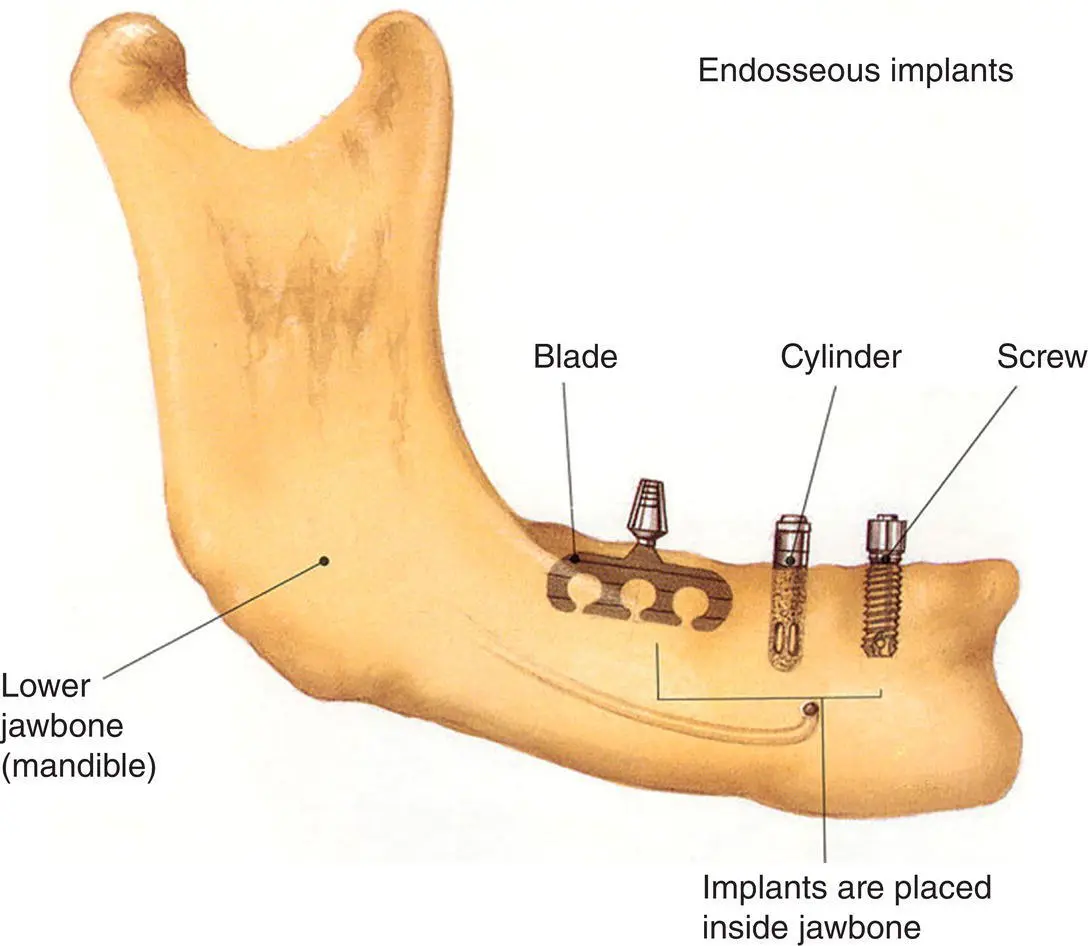
Figure 1.6 Endosteal design.
Juodzbalys and Wang (21).
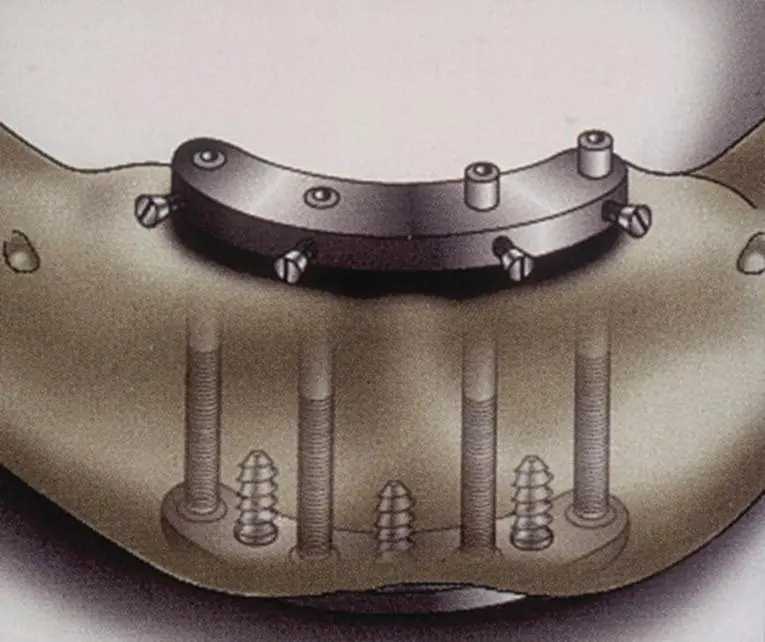
Figure 1.7 Transosteal design.
Reprinted with permission from Zwemer (22) © 2008 Elsevier, Inc. All rights reserved.
Implants
Over the past 30 years, research has validated the success of osseointegrated implants as a viable alternative to fixed or removable prosthetic restorations ( Figure 1.8) (4). Implant placement in the premolar and molar are 95% successful and are considered the first choice in tooth‐replacement options (5, 6). This is supported by the dental literature for many implant systems in every area of the mouth (7). According to Michael Tischler et al. (8, 9), because of “the amount of edentulism currently documented, it is essential for clinicians to incorporate dental implants into everyday practice.” The American Association of Oral and Maxillofacial Surgeons report that 69% of adults between ages 35 and 44 years have lost at least one permanent tooth and 43% of adults over the age of 65 years old are missing six or more teeth due to tooth decay, periodontal disease, a failed root canal, or trauma (8, 9).
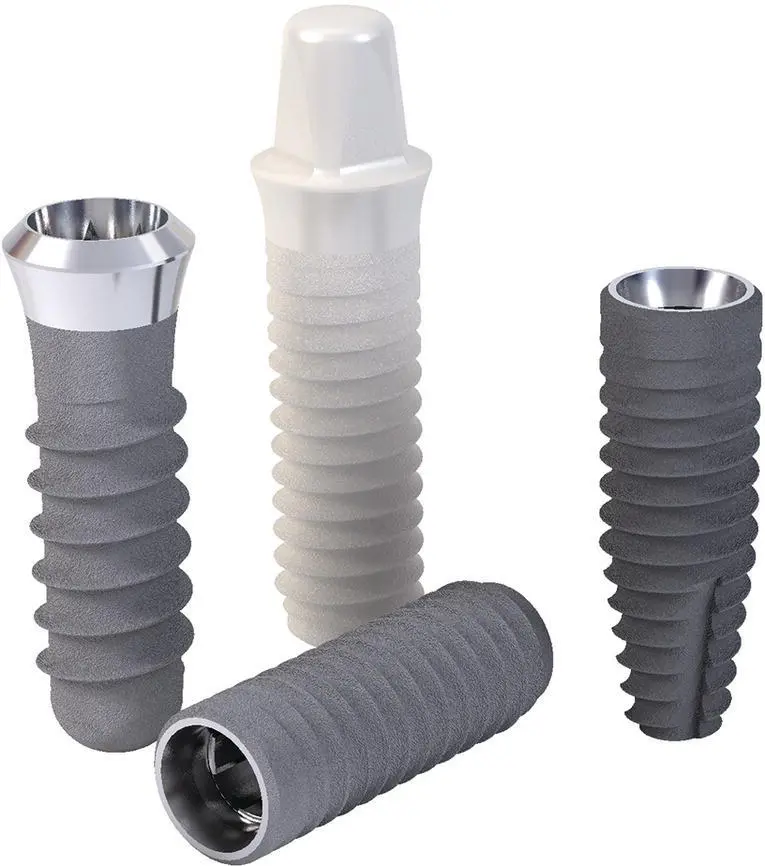
Figure 1.8 Titanium and ceramic (zirconia) implant examples.
Courtesy of Straumann.
As hygienists, these changes have evolved into a new phase of maintenance care for our patients. Before we can understand the new protocols for our maintenance appointments, an understanding of the basics of implants and why most implants are made from titanium alloy is necessary. The choice of which type of implant to use will be in the hands of the surgeon, titanium or ceramic. Hygienists need an understanding of the component parts. The main component parts of an implant are the fixture (design, length, shape, diameter, and surface), transmucosal abutment, and the restoration/prosthesis.
Читать дальшеИнтервал:
Закладка:
Похожие книги на «Peri-Implant Therapy for the Dental Hygienist»
Представляем Вашему вниманию похожие книги на «Peri-Implant Therapy for the Dental Hygienist» списком для выбора. Мы отобрали схожую по названию и смыслу литературу в надежде предоставить читателям больше вариантов отыскать новые, интересные, ещё непрочитанные произведения.
Обсуждение, отзывы о книге «Peri-Implant Therapy for the Dental Hygienist» и просто собственные мнения читателей. Оставьте ваши комментарии, напишите, что Вы думаете о произведении, его смысле или главных героях. Укажите что конкретно понравилось, а что нет, и почему Вы так считаете.

